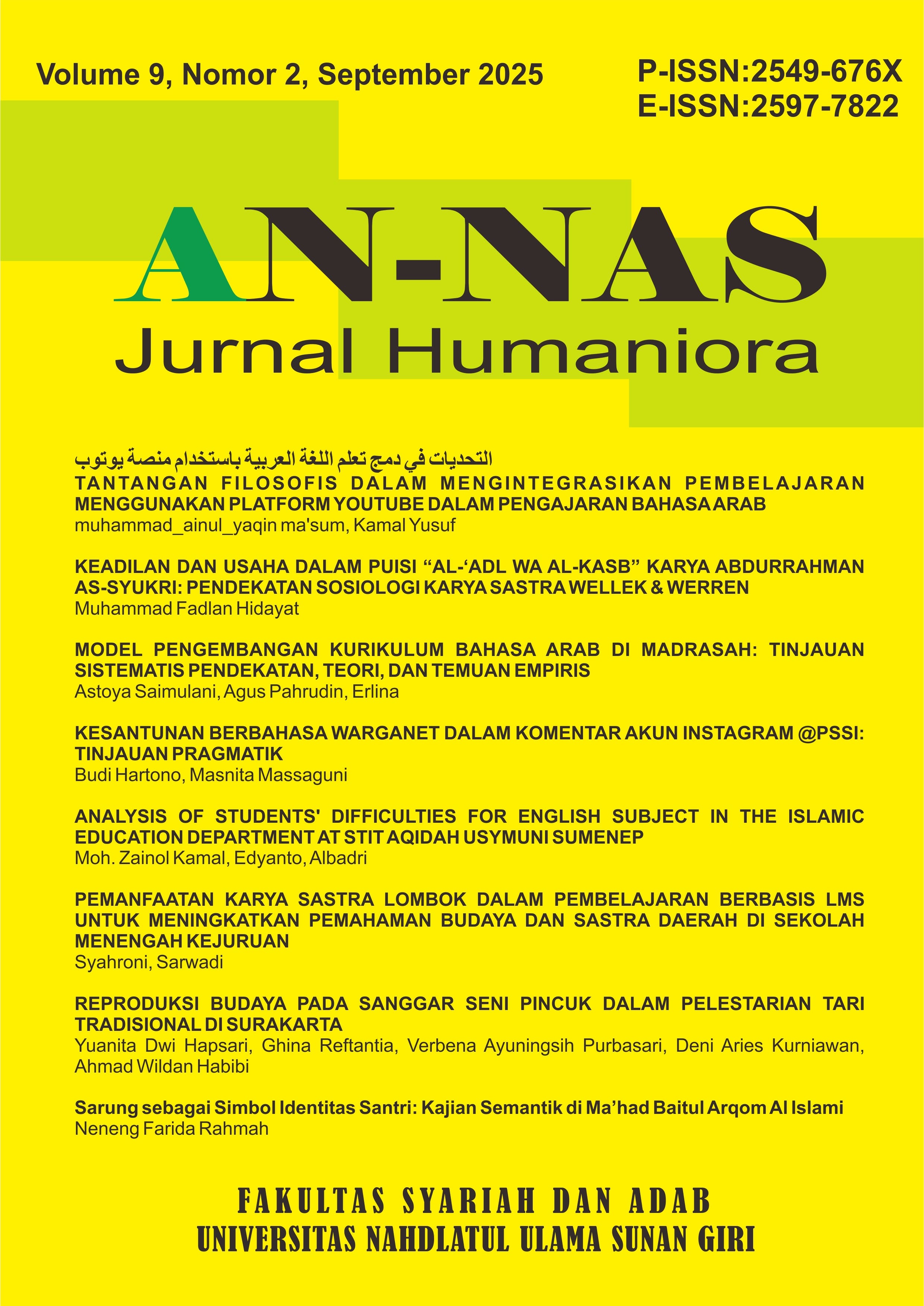TELAAH SIMBOLIK POLA METRUM BAHR TAWIL DALAM SYAIR-SYAIR “ALALA” KARYA IMAM AL-ZARNUJI: PENDEKATAN SEMIOTIKA RIFFATERRE
 PDF Download: 92
PDF Download: 92
DOI:
https://doi.org/10.32665/annas.v9i2.5487Keywords:
Bahr Tawil, Alala Poems, Imam al-Zarnuji, Riffatere’s Semiotic, ArudlAbstract
: This study aims to examine the metrical pattern of Bahr Ṭawīl in the ‘Alāla poems by Imam Al-Zarnuji through the lens of Michael Riffaterre’s semiotic approach. Bahr Ṭawīl is known as one of the oldest meters widely used in the classical Arabic poetic tradition. Beyond serving as a rhythmic element, this metrical pattern also carries symbolic meanings closely related to moral and religious messages. The research employs a descriptive qualitative method with philological and semiotic approaches, encompassing text collection, identification of metrical patterns, and symbolic analysis of the rhythmic structure and the hidden messages within the poems. The findings reveal that the use of Bahr Ṭawīl in ‘Alāla is not merely an adherence to the rules of ʿarūḍ, but also embodies symbols of scholarly values, monotheism, and moral reinforcement for the santri (Islamic boarding school students). This metrical pattern functions as a semiotic medium connecting the text, the poet, and the audience, where the hidden meaning (hypogram) is manifested through the selection of specific wazan and rhythmic repetition. These results affirm that Bahr Ṭawīl in Al-‘Alāla serves not only as an aesthetic element but also as a symbolic means of conveying the educational values of the pesantren tradition.
References
Al-Bukhari, Sahih Al-Bukhari (Beirut: Dar Ibn Kathir, 1987)
Al-Farahidi, Khalil ibn Ahmad, Kitab Al-‘Arud, ed. by ed. (Cairo: Dar al-Ma‘arif, 1974)
al-Ghazali, Abu Hamid, Ihya’ ‘Ulum Al-Din (Beirut: Dar al-Ma‘rifah, 2005) <https://www.ghazali.org/books/ihya-v1.pdf?utm>
al-Syāfiʿī, Syekh Mukhtashar, Ilmu ‘Arudh & Qawafi (Mukhtashar Al-Syāfiʿī (Surabaya: Maktabah Zaen)
Al-Zarnuji, Burhan, Ta‘lim Al-Muta‘allim Tariq Al-Ta‘Allum (Beirut: Dar Ibn Hazm, 2002) <https://ia801504.us.archive.org/31/items/53330826InstructionOfTheStudentTaAlimAlMutaAllimTheMethodOfLearning/53330826-Instruction-of-the-Student-Ta-alim-al-Muta-allim-The-Method-of-Learning.pdf>
Arisandi, Yusuf, and Nurhanifansyah, ‘Innovating Arudh : Simplifying the Complexity of Arabic Poetry’, Lisan Al-‘Arab: Journal of Arabic Studies, 13.2 (2024), 96–108 <https://journal.unnes.ac.id/journals/laa/article/view/14125/2518.>
Bäckström, Per, and O.Life! Forgive Us, The Sin of Death: A Critical Reading of Michael Riffaterre’s Semiotics of Poetry (Karlstad: Karlstad University Studies, 2009)
Barthes, Roland, Image-Music-Text, trans. by Stephen Heath (New York: Hill and Wang, 1977)
Culler, Jonathan, Structuralist Poetics: Structuralism, Linguistics, and the Study of Literature (Ithaca: Cornell University Press)
Dhofier, Zamakhsari, Tradisi Pesantren: Studi Tentang Pandangan Hidup Kyai Dan Visinya Mengenai Masa Depan Indonesia, Lp3Es (Jakarta: LP3ES, 2011)
Griffin, Em, Glenn Sparks, and Andrew Ledbetter, ‘10 A First Look at Communication Theory’, Studying for a Foundation Degree in Health, 2019, pp. 69–92 <https://www.dawsoncollege.qc.ca/ai/wp-content/uploads/sites/180/22-Barthes-Semiotics.pdf>
H., G. F., and A. J. Arberry, Arabic Poetry: A Primer for Students, Journal of the American Oriental Society (Cambridge: Cambridge University Press, 1967), LXXXVII <https://doi.org/10.2307/597502>
Hendricks, William O, ‘Open and Closed’, Chronicle of Higher Education, 2002 <https://doi.org/10.2307/1566871>
Key, Laura E.B., and Brittany Pheiffer Noble, Course in General Linguistics, ed. by Charles Bally and Albert Sechehaye, Course in General Linguistics (New York: McGraw-Hill, 2017) <https://doi.org/10.4324/9781912281732>
Masykuri, M. Saifuddin, Mudah Belajar ’Arudl (Ilmu Syi’ir Bahasa Arab) (Kediri: Santri Salaf Press, 2017)
Peter McCormick, Truth and Method, trans. by Joel Weinsheimer and Donald G Marshall, New Scholasticism, 2nd revise (New York: Continuum, 1977), LI <https://doi.org/10.5840/newscholas197751328>
McFadden, George, and Paul Ricoeur, Interpretation Theory: Discourse and the Surplus of Meaning, The Journal of Aesthetics and Art Criticism (Fort Worth: Texas Christian University Press, 1978), XXXVI <https://doi.org/10.2307/430446>
Nuha, Muhammad Afthon Ulin, and Nurul Musyafaah, ‘The Alignment of the Final Letters in the Alala Book by Sheikh Al-Zarnuji’, Al-Irfan : Journal of Arabic Literature and Islamic Studies, 6.1 (2023), 83–102 <https://doi.org/10.58223/alirfan.v6i1.6442>
Peters, Issa, and Roger Allen, An Introduction to Arabic Literature, World Literature Today (Cambridge: Cambridge University Press, 2001), LXXV <https://doi.org/10.2307/40156979>
Riffaterre, Michael, Semiotics of Poetry, Semiotics of Poetry (Bloomington: Indiana University Press, 2021) <https://doi.org/10.2979/semioticsofpoetry>
Riffaterre, Michael, and Terese Lyons, Text Production, Poetics Today (New York: Columbia University Press, 1984), V <https://doi.org/10.2307/1772452>
Torstrick, Rebecca L., and Elizabeth Faier, Culture and Customs of the Arab Gulf States, Culture and Customs of the Arab Gulf States (Westport: Greenwood Press, 2009) <https://doi.org/10.5040/9798400635861>
Downloads
Published
License
Copyright (c) 2025 Masna Hikmawati, Choiril Ulfi , Ziya'uddin

This work is licensed under a Creative Commons Attribution 4.0 International License.
 PDF Download: 92
PDF Download: 92







